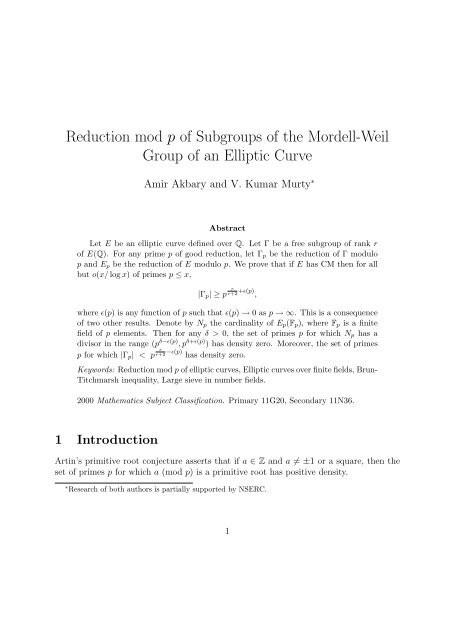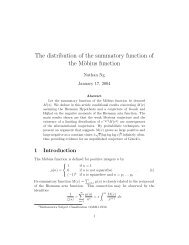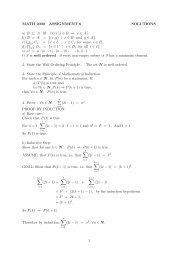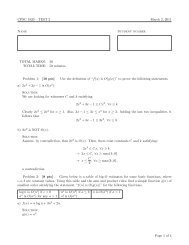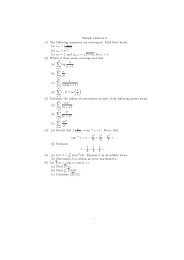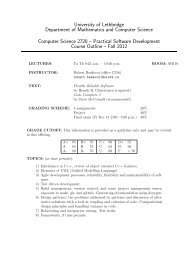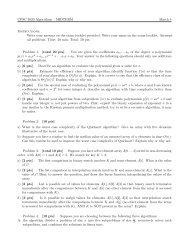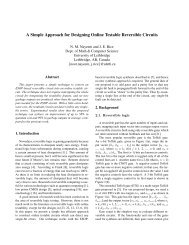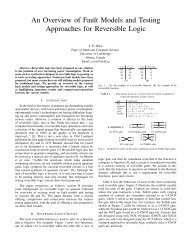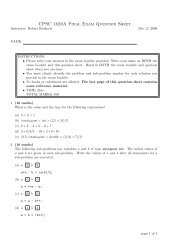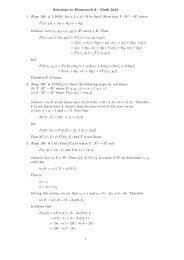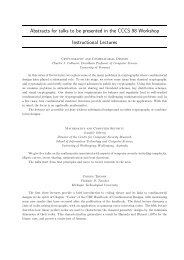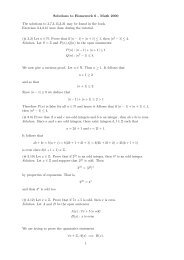Reduction mod p of Subgroups of the Mordell-Weil Group of an ...
Reduction mod p of Subgroups of the Mordell-Weil Group of an ...
Reduction mod p of Subgroups of the Mordell-Weil Group of an ...
You also want an ePaper? Increase the reach of your titles
YUMPU automatically turns print PDFs into web optimized ePapers that Google loves.
<strong>Reduction</strong> <strong>mod</strong> p <strong>of</strong> <strong>Subgroups</strong> <strong>of</strong> <strong>the</strong> <strong>Mordell</strong>-<strong>Weil</strong><br />
<strong>Group</strong> <strong>of</strong> <strong>an</strong> Elliptic Curve<br />
Amir Akbary <strong>an</strong>d V. Kumar Murty ∗<br />
Abstract<br />
Let E be <strong>an</strong> elliptic curve defined over Q. Let Γ be a free subgroup <strong>of</strong> r<strong>an</strong>k r<br />
<strong>of</strong> E(Q). For <strong>an</strong>y prime p <strong>of</strong> good reduction, let Γ p be <strong>the</strong> reduction <strong>of</strong> Γ <strong>mod</strong>ulo<br />
p <strong>an</strong>d E p be <strong>the</strong> reduction <strong>of</strong> E <strong>mod</strong>ulo p. We prove that if E has CM <strong>the</strong>n for all<br />
but o(x/ log x) <strong>of</strong> primes p ≤ x,<br />
|Γ p | ≥ p r<br />
r+2 +ɛ(p) ,<br />
where ɛ(p) is <strong>an</strong>y function <strong>of</strong> p such that ɛ(p) → 0 as p → ∞. This is a consequence<br />
<strong>of</strong> two o<strong>the</strong>r results. Denote by N p <strong>the</strong> cardinality <strong>of</strong> E p (F p ), where F p is a finite<br />
field <strong>of</strong> p elements. Then for <strong>an</strong>y δ > 0, <strong>the</strong> set <strong>of</strong> primes p for which N p has a<br />
divisor in <strong>the</strong> r<strong>an</strong>ge (p δ−ɛ(p) , p δ+ɛ(p) ) has density zero. Moreover, <strong>the</strong> set <strong>of</strong> primes<br />
p for which |Γ p | < p r<br />
r+2 −ɛ(p) has density zero.<br />
Keywords: <strong>Reduction</strong> <strong>mod</strong> p <strong>of</strong> elliptic curves, Elliptic curves over finite fields, Brun-<br />
Titchmarsh inequality, Large sieve in number fields.<br />
2000 Ma<strong>the</strong>matics Subject Classification. Primary 11G20, Secondary 11N36.<br />
1 Introduction<br />
Artin’s primitive root conjecture asserts that if a ∈ Z <strong>an</strong>d a ≠ ±1 or a square, <strong>the</strong>n <strong>the</strong><br />
set <strong>of</strong> primes p for which a (<strong>mod</strong> p) is a primitive root has positive density.<br />
∗ Research <strong>of</strong> both authors is partially supported by NSERC.<br />
1
More generally, we may consider <strong>an</strong> algebraic group G defined over Q <strong>an</strong>d Γ a finitely<br />
generated subgroup <strong>of</strong> G(Q). For all but a finite number <strong>of</strong> primes p, <strong>the</strong>re is a natural<br />
reduction map<br />
Γ → G(F p ) (1)<br />
<strong>an</strong>d we may ask for <strong>the</strong> distribution <strong>of</strong> primes p for which this map is surjective. Thus,<br />
in <strong>the</strong> classical Artin primitive root conjecture, G = G m <strong>an</strong>d Γ is <strong>the</strong> subgroup generated<br />
by a.<br />
L<strong>an</strong>g <strong>an</strong>d Trotter [LT] considered <strong>the</strong> case where G is <strong>an</strong> elliptic curve E <strong>an</strong>d Γ is a<br />
free subgroup <strong>of</strong> <strong>the</strong> group <strong>of</strong> rational point E(Q). Signific<strong>an</strong>t results on this question<br />
were obtained by Gupta <strong>an</strong>d R. Murty [GM]. In particular, <strong>the</strong>y showed assuming <strong>the</strong><br />
Generalized Riem<strong>an</strong>n Hypo<strong>the</strong>sis that if <strong>the</strong> r<strong>an</strong>k <strong>of</strong> Γ is sufficiently large, <strong>the</strong>n <strong>the</strong> set <strong>of</strong><br />
primes for which (1) is surjective has a density.<br />
It is also <strong>of</strong> interest to consider lower bounds on <strong>the</strong> size <strong>of</strong> <strong>the</strong> image in (1). Let Γ be a<br />
subgroup <strong>of</strong> Q ∗ generated by r non-zero multiplicatively independent rationals a 1 , · · · , a r .<br />
For all primes p not dividing <strong>the</strong> numerators <strong>an</strong>d <strong>the</strong> denominators <strong>of</strong> a 1 , · · · , a r , we let<br />
Γ p be <strong>the</strong> reduction <strong>of</strong> Γ <strong>mod</strong> p. Erdös <strong>an</strong>d R. Murty [EM] proved <strong>the</strong> following <strong>the</strong>orem<br />
regarding <strong>the</strong> size <strong>of</strong> Γ p as p varies.<br />
Theorem 1.1 (Erdös <strong>an</strong>d R. Murty) Let ɛ(x) be <strong>an</strong>y function tending to zero as<br />
x → ∞. Then for all but o(x/ log x) primes p ≤ x,<br />
|Γ p | ≥ p r<br />
r+1 +ɛ(p) .<br />
In this paper we prove <strong>an</strong> elliptic <strong>an</strong>alogue <strong>of</strong> this result. More precisely, Let E be <strong>an</strong><br />
elliptic curve defined over Q. For <strong>an</strong>y prime p <strong>of</strong> good reduction, let E p be <strong>the</strong> elliptic<br />
curve over F p obtained by reducing E <strong>mod</strong>ulo p. By <strong>the</strong> <strong>Mordell</strong> <strong>the</strong>orem we know that<br />
E(Q) is finitely generated. Let Γ be a free subgroup <strong>of</strong> r<strong>an</strong>k r <strong>of</strong> E(Q) <strong>an</strong>d let Γ p be <strong>the</strong><br />
reduction <strong>of</strong> Γ <strong>mod</strong> p. One c<strong>an</strong> ask how <strong>the</strong> size <strong>of</strong> Γ p grows as p → ∞. For arbitrary<br />
r one c<strong>an</strong> prove <strong>the</strong> following result which is implicit in <strong>the</strong> work <strong>of</strong> Mat<strong>the</strong>ws [M] <strong>an</strong>d<br />
Gupta <strong>an</strong>d R. Murty [GM].<br />
Proposition 1.2 Let E be <strong>an</strong> elliptic curve over Q <strong>an</strong>d Γ be a free subgroup <strong>of</strong> r<strong>an</strong>k r <strong>of</strong><br />
E(Q). Let ɛ(p) be a function <strong>of</strong> p such that ɛ(p) → 0 <strong>an</strong>d p ɛ(p) increases monotonically to<br />
∞ as p → ∞. Then for all but o(x/ log x) <strong>of</strong> primes p ≤ x, we have<br />
|Γ p | ≥ p r<br />
r+2 −ɛ(p) .<br />
In this paper we improve <strong>the</strong> above bound for <strong>the</strong> case that E is a CM elliptic curve.<br />
From now on let E have CM by <strong>the</strong> entire ring <strong>of</strong> integers <strong>of</strong> <strong>an</strong> imaginary quadratic field<br />
K, <strong>an</strong>d for a prime <strong>of</strong> good reduction let N p = #E p (F p ).<br />
2
Theorem 1.3 Let E be a CM elliptic curve. Let Γ be a free subgroup <strong>of</strong> r<strong>an</strong>k r <strong>of</strong> E(Q).<br />
Let Γ p be <strong>the</strong> reduction <strong>of</strong> Γ <strong>mod</strong> p. Let ɛ(p) be a function <strong>of</strong> p such that ɛ(p) → 0 as<br />
p → ∞. Then for all but o(x/ log x) <strong>of</strong> primes p ≤ x, we have<br />
Next let<br />
R. Murty, Rosen <strong>an</strong>d Silverm<strong>an</strong> proved that<br />
|Γ p | ≥ p r<br />
r+2 +ɛ(p) .<br />
P Γ (θ) = {primes p such that |Γ p | ≤ p θ }.<br />
˜δ(P Γ (θ)) ≤<br />
(<br />
1 + 2 )<br />
θ,<br />
r<br />
where ˜δ( ) denotes <strong>the</strong> upper logarithmic Dirichlet density <strong>of</strong> a set. We observe that this<br />
result is non-trivial only if θ ≤ . The following is a direct consequence <strong>of</strong> Theorem 1.3.<br />
r<br />
r+2<br />
Corollary 1.4 Let θ ≤<br />
r . Then under <strong>the</strong> assumptions <strong>of</strong> Theorem 1.3, P r+2 Γ(θ) has<br />
density zero <strong>an</strong>d so ˜δ(P Γ (θ)) = 0.<br />
To prove our results, several tools are necessary. Firstly, we need to establish a Brun-<br />
Titchmarsh type inequality for N p <strong>an</strong>d we do this in Section 2. Also, we need information<br />
about <strong>the</strong> normal order <strong>of</strong> <strong>the</strong> number <strong>of</strong> divisors <strong>of</strong> N p which discuss in Section 3. Ano<strong>the</strong>r<br />
import<strong>an</strong>t tool that we need is a version <strong>of</strong> <strong>the</strong> large sieve inequality for integers in <strong>an</strong><br />
imaginary quadratic field. All <strong>of</strong> <strong>the</strong>se tools are used to prove a key technical <strong>the</strong>orem<br />
(Theorem 4.1). This is stated in Section 4 along with a strategy to prove it. The pro<strong>of</strong><br />
itself is given in Sections 5, 6, <strong>an</strong>d 7. Finally, in Sections 8 <strong>an</strong>d 9 <strong>the</strong> pro<strong>of</strong>s <strong>of</strong> Proposition<br />
1.2 <strong>an</strong>d Theorem 1.4 are given.<br />
We make some remarks regarding <strong>the</strong> <strong>an</strong>alogue <strong>of</strong> Theorem 1.3 for elliptic curves<br />
without complex multiplication. A key tool that we use is <strong>the</strong> Brun-Titchmarsh inequality<br />
for N p . In <strong>the</strong> non-CM case, this has not yet been proved. Moreover, even assuming <strong>the</strong><br />
Generalized Riem<strong>an</strong>n Hypo<strong>the</strong>sis, <strong>the</strong> error term in <strong>the</strong> Chebotarev density <strong>the</strong>orem grows<br />
too rapidly for <strong>an</strong> argument to work. Thus, at present, without additional hypo<strong>the</strong>sis,<br />
we are not able to prove <strong>the</strong> <strong>an</strong>alogue <strong>of</strong> Theorem 1.3 in <strong>the</strong> non complex multiplication<br />
case. However this difficulty c<strong>an</strong> be overcome if we assume that Γ has sufficiently large<br />
r<strong>an</strong>k.<br />
3
2 Brun-Titchmarsh inequality for N p<br />
From now on p denote a rational prime <strong>an</strong>d l denote <strong>an</strong> integer that may or may not be<br />
prime. Let (a, l) = 1 <strong>an</strong>d define<br />
π(x; l, a) = ∑ p≤x<br />
l|p−a<br />
The classical Brun-Titchmarsh inequality in its sharpest known form (due to Montgomery<br />
<strong>an</strong>d Vaugh<strong>an</strong> [MV]) states that<br />
π(x; l, a) ≤<br />
1.<br />
2x<br />
φ(l) log (x/l)<br />
for 1 ≤ l < x. Here we are interested in <strong>an</strong> <strong>an</strong>alogue <strong>of</strong> this inequality for divisors <strong>of</strong> N p<br />
<strong>of</strong> <strong>an</strong> elliptic curve.<br />
Let E be <strong>an</strong> elliptic curve defined over Q which has complex multiplication by <strong>the</strong><br />
entire ring <strong>of</strong> integers O K <strong>of</strong> <strong>an</strong> imaginary quadratic field K. We w<strong>an</strong>t to obtain <strong>an</strong> upper<br />
bound for<br />
π E (x; l) = ∑ ′<br />
1.<br />
p≤x<br />
l|Np<br />
In <strong>the</strong> above sum ′ me<strong>an</strong>s that <strong>the</strong> sum is taken over primes <strong>of</strong> good reduction.<br />
To establish such a bound, we closely follow <strong>the</strong> arguments given in Lemma 14 <strong>of</strong> [C].<br />
For simplicity, we first consider <strong>the</strong> case that l is prime, <strong>an</strong>d <strong>the</strong>n we study <strong>the</strong> general<br />
case.<br />
prime l<br />
We break <strong>the</strong> sum into <strong>the</strong> following sums.<br />
′ ∑ ′ ∑ ′<br />
1 = 1 + 1 = (I) + (II).<br />
π E (x; l) = ∑ p≤x<br />
l|Np<br />
p≤x,ss<br />
l|Np<br />
p≤x,ord<br />
l|Np<br />
Here ss st<strong>an</strong>ds for supersingular <strong>an</strong>d ord st<strong>an</strong>ds for ordinary. Now we estimate each <strong>of</strong><br />
<strong>the</strong> above sums.<br />
(I) In this case we have N p = p + 1 <strong>an</strong>d so by <strong>the</strong> Brun-Titchmarsh inequality<br />
∑<br />
p≤x,ss<br />
l|Np<br />
′<br />
1 ≤ π(x; l, −1) ≤<br />
2x<br />
φ(l) log (x/l)<br />
4
for l < x.<br />
(II) To study <strong>the</strong> o<strong>the</strong>r sum, we need <strong>the</strong> following lemma which is a simple corollary<br />
<strong>of</strong> Theorem 6 <strong>of</strong> [S].<br />
Lemma 2.1 Let l be <strong>an</strong> integral ideal <strong>of</strong> <strong>an</strong> imaginary quadratic field K. For x ≥ 2, let<br />
π K (x; l, 1) = #{ω ∈ O K ; N(ω) ≤ x, (ω) a prime ideal,<br />
ω ≡ 1 (<strong>mod</strong> l)}.<br />
Then we have<br />
π K (x; l, 1) ≪ K<br />
x<br />
φ(l) log (x/N(l))<br />
as long as N(l) ≤<br />
x . Here N(ω) = ω¯ω, φ(l) = |(O log x K/l) ∗ | is <strong>the</strong> number <strong>of</strong> invertible<br />
residue classes <strong>mod</strong> l, <strong>an</strong>d N(l) is <strong>the</strong> norm <strong>of</strong> <strong>the</strong> ideal l in <strong>the</strong> extension K/Q. The<br />
implied const<strong>an</strong>t in <strong>the</strong> inequality depends only on K.<br />
From <strong>the</strong> <strong>the</strong>ory <strong>of</strong> complex multiplication we know that for <strong>an</strong> ordinary prime p <strong>the</strong>re<br />
is a unique choice <strong>of</strong> <strong>an</strong> element π p ∈ O K such that π p represents <strong>the</strong> p-power Frobenius<br />
morphism, p = π p¯π p , (π p ) is a prime ideal <strong>of</strong> O K , <strong>an</strong>d K = Q(π p ). Moreover, in this case<br />
N p = (π p − 1)(¯π p − 1)<br />
<strong>an</strong>d K has class number 1. (For more information regarding <strong>the</strong>se facts see Chapter 5<br />
<strong>an</strong>d Appendix C <strong>of</strong> [Si].)<br />
Now (l) c<strong>an</strong> be <strong>an</strong> inert prime, a split prime or a ramified prime in K. We consider<br />
each <strong>of</strong> <strong>the</strong>se cases in turn.<br />
(II-in) Since (l) is inert, so (l) is a prime in O K , <strong>an</strong>d so<br />
l | N p<br />
⇐⇒ π p ≡ 1 (<strong>mod</strong> (l)).<br />
Now from here <strong>an</strong>d Lemma 2.1 we have<br />
(<br />
for l ≤<br />
x 1/2.<br />
log x)<br />
∑<br />
p≤x,ord<br />
l|Np,in<br />
(II-sp) In this case (l) = l 1 l 2 . So<br />
′<br />
1 ≤ πK (x; (l), 1) ≪<br />
x<br />
(l 2 − 1) log(x/l 2 ) ,<br />
l | N p ⇐⇒ π p ≡ 1 (<strong>mod</strong> l 1 ) or π p ≡ 1 (<strong>mod</strong> l 2 ).<br />
5
So from here <strong>an</strong>d Lemma 2.1 we have<br />
for l ≤<br />
x . log x<br />
∑<br />
p≤x,ord<br />
l|Np,sp<br />
(II-ram) In this case (l) = l 2 . So<br />
′<br />
1 ≤ πK (x; l 1 , 1) + π K (x; l 2 , 1) ≪<br />
x<br />
φ(l) log(x/l) ,<br />
l | N p<br />
⇐⇒ π p ≡ 1 (<strong>mod</strong> l).<br />
So from here <strong>an</strong>d Lemma 2.1 we have<br />
∑<br />
p≤x,ord<br />
l|Np,ram<br />
′<br />
1 ≤ πK (x; l, 1) ≪<br />
for l ≤<br />
x . log x<br />
Putting everything toge<strong>the</strong>r, for l prime, we have<br />
π E (x; l) ≪ K<br />
x<br />
φ(l) log(x/l) ,<br />
x<br />
φ(l) log (x/l 2 ) ,<br />
( )<br />
x 1/2.<br />
for l ≤<br />
log x<br />
General l<br />
Now we drop <strong>the</strong> restriction that l is prime. The <strong>an</strong>alysis <strong>of</strong> <strong>the</strong> first sum (I) is<br />
<strong>the</strong> same, so we assume that p is ordinary. We first decompose l as l = l in l sp l ram =<br />
( ∏ i pα i<br />
i )( ∏ j qβ j<br />
j )(∏ k rγ k<br />
k ), where (p i)’s are inert, (q j )’s are split <strong>an</strong>d (r k )’s are ramified in<br />
K. We have<br />
Now note that<br />
l|N p ⇐⇒ p α i<br />
i<br />
|N p , q β j<br />
j |N p, r γ k<br />
k |N p, for all i, j, k.<br />
p α i<br />
i |N p ⇒ π p ≡ 1 (<strong>mod</strong> (p i ) δ i<br />
),<br />
where<br />
{ [ αi<br />
]<br />
δ i = 2 + 1 if αi is odd<br />
α i<br />
if α<br />
2 i is even .<br />
Next let η j be <strong>the</strong> highest power <strong>of</strong> q j in <strong>the</strong> factorization <strong>of</strong> N p . Since K is a principal<br />
ideal domain, <strong>the</strong>re is a unique integer α in O K such that<br />
e N p<br />
q η j−β j<br />
j<br />
6<br />
= αᾱ,
where α | π p − 1, ᾱ | ¯π p − 1, <strong>an</strong>d e is a unit <strong>of</strong> K. Since (q i ) splits we have (q j ) = q j1 q j2 .<br />
Let µ j1 be <strong>the</strong> highest power <strong>of</strong> q j1 in <strong>the</strong> prime factorization <strong>of</strong> (α) <strong>an</strong>d µ j2 <strong>the</strong> highest<br />
power <strong>of</strong> q j2 in <strong>the</strong> prime factorization <strong>of</strong> (α). We have<br />
where<br />
q β j<br />
j |N p ⇒ π p ≡ 1 (<strong>mod</strong> q µ j1<br />
j1 qµ j2<br />
j2 ),<br />
µ j1 + µ j2 = β j .<br />
Finally<br />
r γ k<br />
k |N p ⇒ π p ≡ 1 (<strong>mod</strong> r γ k<br />
k ),<br />
where (r k ) = r 2 k . Let J denote <strong>the</strong> set <strong>of</strong> indices j. For each function<br />
given by<br />
where 0 ≤ µ j,1 ≤ β j , set<br />
<strong>an</strong>d consider <strong>the</strong> ideal<br />
a f = ∏ i<br />
f : J −→ Z<br />
f(j) = µ j,1<br />
µ j,2 = β j − f(j)<br />
∏<br />
(p i ) δ i<br />
j<br />
q µ j1<br />
j1 qµ j2<br />
j2<br />
Note that <strong>the</strong> number <strong>of</strong> such maps f is<br />
∏<br />
(β j + 1) = d(l sp ).<br />
It is clear that<br />
j<br />
∏<br />
l|N p ⇒ π p ≡ 1 (<strong>mod</strong> a f ),<br />
for some a f . From here <strong>an</strong>d Lemma 2.1, we have<br />
∑<br />
p≤x,ord<br />
l|Np<br />
′ ∑<br />
1 ≤ π K (x; a f , 1)<br />
≪ K<br />
f<br />
∏<br />
j<br />
∑<br />
1<br />
φ(q µ j1<br />
µ j1 +µ j2 =β j j<br />
∏<br />
i (p2δ i<br />
i<br />
)φ(q µ j2<br />
k<br />
j )<br />
− p 2δ i−2<br />
i ) ∏ k φ(rγ k<br />
k )<br />
r γ k<br />
k .<br />
(<br />
log<br />
x<br />
Q<br />
i p2δ i<br />
for ∏ i p2δ i<br />
i l sp l ram ≤ x . So we have <strong>the</strong> following proposition.<br />
log x<br />
7<br />
),<br />
x<br />
i l spl ram
Proposition 2.2 Let E be <strong>an</strong> elliptic curve over Q which has complex multiplication by<br />
<strong>the</strong> ring <strong>of</strong> integers <strong>of</strong> <strong>an</strong> imaginary quadratic number field K. Let l = l in l sp l ram . Then<br />
2 ω(lsp) d(l sp ) x<br />
π E (x; l) ≪ K<br />
φ(l) log (x/l 2 ) ,<br />
(<br />
x 1/2.<br />
for l ≤<br />
log x)<br />
Here, ω(lsp ) is <strong>the</strong> number <strong>of</strong> distinct prime divisors <strong>of</strong> l sp , d(l sp ) is <strong>the</strong><br />
number <strong>of</strong> divisors <strong>of</strong> l sp , <strong>an</strong>d φ(l) is <strong>the</strong> Euler function.<br />
Proposition 2.3 Under <strong>the</strong> conditions <strong>of</strong> <strong>the</strong> Proposition 2.2 we have<br />
d(l sp )<br />
π E (x; l) ≪ K x,<br />
l<br />
where <strong>the</strong> implied const<strong>an</strong>t depends only on K.<br />
Pro<strong>of</strong> Following <strong>the</strong> arguments before Proposition 2.2, we have<br />
π E (x; l) ≤ π(x; l, −1) + ∑ f<br />
π(x; a f , 1).<br />
Note that since K is <strong>an</strong> imaginary quadratic field <strong>of</strong> class number 1, we have<br />
Therefore<br />
π K (x; a, 1) ≤ #{ω ∈ O K ; N(ω) ≤ x, ω ≡ 1 (<strong>mod</strong> a)}<br />
≤ #{γ ∈ O K ; N(γ) ≪ x<br />
N(a) }<br />
x<br />
≪ K<br />
N(a) .<br />
x<br />
π E (x; l) ≪ K<br />
l + d(l sp )x<br />
∏<br />
i p2δ i<br />
i l sp l ram<br />
d(l sp )<br />
≪ K x.<br />
l<br />
3 Normal order <strong>of</strong> ω(N p )<br />
In [C] <strong>an</strong>d [L], Cojocaru <strong>an</strong>d Liu independently proved that for a CM elliptic curve over<br />
Q, <strong>the</strong> normal order <strong>of</strong> ω(N p ) is log log p, where ω(n) denotes <strong>the</strong> number <strong>of</strong> distinct prime<br />
divisors <strong>of</strong> n. This me<strong>an</strong>s that given ɛ > 0,<br />
#{p ≤ x, |ω(N p ) − log log p| > ɛ log log p} = o(π(x)),<br />
8
where π(x) denotes <strong>the</strong> number <strong>of</strong> primes not exceeding x. Cojocaru <strong>an</strong>d Liu’s result is<br />
a consequence <strong>of</strong> <strong>the</strong> following <strong>the</strong>orem.<br />
Theorem 3.1 (Cojocaru <strong>an</strong>d Liu) For y < x 1 6 , we have<br />
∑<br />
π E (x; l) = π(x) log log y + O(π(x)),<br />
<strong>an</strong>d for y < x 1<br />
12 we have<br />
∑<br />
l 1 ,l 2 ≤y<br />
l 1 ≠l 2 prime<br />
l≤y<br />
l prime<br />
π E (x; l 1 l 2 ) = π(x)(log log y) 2 + O(π(x) log log y).<br />
Pro<strong>of</strong> See <strong>the</strong> pro<strong>of</strong> <strong>of</strong> Theorem 1 in [L] or <strong>the</strong> pro<strong>of</strong> <strong>of</strong> Theorem 5 in [C]. □<br />
To explain our next statement we need to introduce some notations. Let ɛ(x) be a<br />
function such ɛ(x) → 0 as x → ∞. For simplicity we write ɛ(x) as ɛ. We call a number<br />
a C if it is only composed <strong>of</strong> primes in <strong>the</strong> interval (x ɛ , x δ ], where 0 < δ < 1 is a fixed<br />
number. We denote by C(N p ) <strong>the</strong> largest C that divides N p . We claim that <strong>the</strong> normal<br />
order <strong>of</strong> C(N p ) is ξ(p), where ξ = log (1/ɛ). More precisely we have<br />
Proposition 3.2 ∑ p≤x′<br />
(ω(C(Np )) − ξ) 2 = O(π(x)ξ). Here ′ me<strong>an</strong>s that <strong>the</strong> sum is taken<br />
over primes <strong>of</strong> good reduction.<br />
Pro<strong>of</strong><br />
We have<br />
∑′ (ω(C(Np )) − ξ) 2<br />
p≤x<br />
= ∑ p≤x<br />
′<br />
ω 2 (C(N p )) − 2ξ ∑ p≤x<br />
′<br />
ω(C(Np )) + π(x)ξ 2 . (2)<br />
If δ < 1 , we get from Theorem 3.1 that<br />
6<br />
∑<br />
′ ∑<br />
ω(C(Np )) =<br />
p≤x′ ∑ 1<br />
p≤x l|Np<br />
x ɛ
If δ ≥ 1 , <strong>the</strong> same result is again true, since<br />
6<br />
∑<br />
p≤x<br />
′ ∑<br />
1 = ∑<br />
l|Np p≤x<br />
x ɛ
Remark. Note that this is false for δ = 0. For example, if t = |E(Q) tors | > 1 <strong>the</strong>n N p<br />
has a divisor that is O(1), namely t itself.<br />
We will prove Theorem 4.1 in <strong>the</strong> case ɛ 1 (x) = ɛ(x) <strong>an</strong>d ɛ 2 (x) = 0. The pro<strong>of</strong> for <strong>the</strong><br />
remaining case ɛ 1 (x) = 0 <strong>an</strong>d ɛ 2 (x) = ɛ(x) is exactly similar. For simplicity we write ɛ(x)<br />
as ɛ. Also without loss <strong>of</strong> generality we assume that x ɛ → ∞, since o<strong>the</strong>rwise we c<strong>an</strong><br />
replace ɛ with a bigger function ɛ ′ such that ɛ ′ → 0 <strong>an</strong>d x ɛ′ → ∞ as x → ∞. Then <strong>the</strong><br />
<strong>the</strong>orem for ɛ follows from <strong>the</strong> <strong>the</strong>orem for ɛ ′ .<br />
The strategy <strong>of</strong> our pro<strong>of</strong> is inspired by a pro<strong>of</strong> <strong>of</strong> a <strong>the</strong>orem <strong>of</strong> Erdös [E], regarding<br />
<strong>the</strong> set <strong>of</strong> multiples <strong>of</strong> a special sequence, given in [HR], Chapter V, Theorem 16. To<br />
prove <strong>the</strong> <strong>the</strong>orem we need to introduce some notations. Let<br />
( ) 1<br />
ξ = log , I = [1, x ɛ ], <strong>an</strong>d J = (x ɛ , x δ ].<br />
ɛ<br />
We use <strong>the</strong> letter A for <strong>an</strong> integer that is entirely composed <strong>of</strong> primes in I <strong>an</strong>d denote<br />
<strong>the</strong> greatest A that divides N p by A(N p ) .<br />
Recall that <strong>the</strong> letter C represents <strong>an</strong> integer that is entirely composed <strong>of</strong> primes in<br />
<strong>the</strong> interval J <strong>an</strong>d <strong>the</strong> greatest C that divides N p is denoted by C(N p ).<br />
We denote by B those square-free C’s that are in <strong>the</strong> interval (x δ−(ɛ+ɛξ) , x δ ].<br />
Finally we call a square-free C a C ∗ if it satisfies <strong>the</strong> following two conditions:<br />
(i) ω(C ∗ ) ≤ 4 3 ξ.<br />
(ii) C ∗ has a representation in <strong>the</strong> form C ∗ = BC.<br />
The pro<strong>of</strong> <strong>of</strong> Theorem 4.1 proceeds as follows.<br />
Let<br />
D = {p ≤ x; ∃d | N p such that x δ−ɛ < d ≤ x δ }.<br />
Let A(n) (respectively C(n)) be <strong>the</strong> largest A (respectively C) that divides n. We consider<br />
<strong>the</strong> following four subsets <strong>of</strong> D.<br />
D 1 = {p ∈ D; C(N p ) is divisible by <strong>the</strong> square <strong>of</strong> a prime},<br />
D 2 = {p ∈ D; ω(C(N p )) > 4 3 ξ},<br />
D 3 = {p ∈ D; A(d) > x ɛξ },<br />
D 4 = {p ∈ D; C(N p ) is a C ∗ }.<br />
We observe that<br />
D ⊂ D 1 ∪ D 2 ∪ D 3 ∪ D 4 .<br />
11
We claim that <strong>the</strong> density <strong>of</strong> each <strong>of</strong> <strong>the</strong>se 4 sets in <strong>the</strong> set <strong>of</strong> primes is zero, which proves<br />
<strong>the</strong> <strong>the</strong>orem. Corollary 3.3 shows this assertion for D 2 . In <strong>the</strong> next section we prove <strong>the</strong><br />
claim for D 1 <strong>an</strong>d D 4 . Finally in section 6 we prove <strong>the</strong> claim for D 3 .<br />
Note. If p is supersingular <strong>the</strong>n N p = p+1, thus <strong>the</strong> estimations for supersingular primes<br />
in D 1 , D 2 , D 3 , <strong>an</strong>d D 4 are exactly similar to <strong>the</strong> p − 1 estimates <strong>of</strong> [EM]. So without loss<br />
<strong>of</strong> generality, in <strong>the</strong> next section, we do our computations only for ordinary primes. Also<br />
note that δ is a fixed const<strong>an</strong>t, however ɛ <strong>an</strong>d ξ are functions <strong>of</strong> x.<br />
5 Lemmas on C’s, B’s, <strong>an</strong>d A’s<br />
Lemma 5.1 The number <strong>of</strong> primes p ≤ x such that C(N p ) is divisible by <strong>the</strong> square <strong>of</strong> a<br />
prime (> x ɛ ) is bounded by<br />
π(x)<br />
x ɛ + x 4 5 .<br />
Pro<strong>of</strong><br />
The number in question is bounded by<br />
∑<br />
π E (x; l 2 ).<br />
l>x ɛ<br />
l prime<br />
Using Propositions 2.2 <strong>an</strong>d 2.3, one c<strong>an</strong> deduce that<br />
∑<br />
l>x ɛ<br />
l prime<br />
π E (x; l 2 ) =<br />
∑<br />
x ɛ
Lemma 5.2 We have<br />
with <strong>an</strong> absolute implied const<strong>an</strong>t where<br />
L(z) =<br />
|S(A, P)| ≪ u + z2<br />
L(z)<br />
∑<br />
N(d)≤z<br />
µ 2 (d) ∏ p|d<br />
λ(p)<br />
N(p) − λ(p) .<br />
Here µ(d) is <strong>the</strong> <strong>an</strong>alogue <strong>of</strong> <strong>the</strong> classical Möbius function.<br />
Pro<strong>of</strong> See [H] <strong>an</strong>d Corollary 5.18 <strong>of</strong> [K]. □<br />
We also need <strong>the</strong> following lemma in <strong>the</strong> pro<strong>of</strong> <strong>of</strong> Propositions 5.4 <strong>an</strong>d 5.5.<br />
Lemma 5.3 Let P be <strong>the</strong> set <strong>of</strong> prime ideals in O K with norm less th<strong>an</strong> or equal to z.<br />
Let P 1 be a subset <strong>of</strong> P <strong>an</strong>d P 2 be <strong>the</strong> complement <strong>of</strong> P 1 in P. Let P 1 (respectively P 2 )<br />
be <strong>the</strong> product <strong>of</strong> <strong>the</strong> elements <strong>of</strong> P 1 (respectively P 2 ). Set<br />
{ 1 if p | P1 ,<br />
λ(p) =<br />
2 if p | P 2 .<br />
Then<br />
L(z) =<br />
∑<br />
N(d)≤z<br />
µ 2 (d) ∏ p|d<br />
where <strong>the</strong> implied const<strong>an</strong>t depends only on K.<br />
λ(p)<br />
N(p) − λ(p) ≫ ∏ (<br />
1 − 1 )<br />
(log z) 2 ,<br />
N(p)<br />
p|P 1<br />
Pro<strong>of</strong><br />
We have<br />
L(z) = ∑<br />
N(d)≤z<br />
= ∑<br />
=<br />
≥<br />
N(d)≤z<br />
∑<br />
N(s(m))≤z<br />
∑<br />
N(m)≤z<br />
µ 2 (d)λ(d)<br />
N(d)<br />
µ 2 (d)λ(d)<br />
N(d)<br />
λ(m)<br />
N(m)<br />
λ(m)<br />
∏<br />
(<br />
1 − λ(p) ) −1<br />
N(p)<br />
p|d<br />
∏<br />
(<br />
1 + λ(p)<br />
)<br />
N(p) + λ2 (p)<br />
N(p) + · · ·<br />
p|d<br />
N(m) , 13
where s(m) denotes <strong>the</strong> square-free part <strong>of</strong> <strong>the</strong> ideal m <strong>an</strong>d λ(m) is <strong>the</strong> completely multiplicative<br />
function defined by λ(p). Let m 2 be <strong>the</strong> largest divisor <strong>of</strong> m whose prime divisors<br />
composed entirely <strong>of</strong> primes <strong>of</strong> P 2 . Then we have<br />
∑<br />
N(m)≤z<br />
Now <strong>the</strong> result follows since<br />
<strong>an</strong>d<br />
∑<br />
N(e)≤ √ z<br />
(e,P 1 )=1<br />
λ(m)<br />
N(m)<br />
≥<br />
∑<br />
N(m)≤z<br />
= ∑<br />
≥<br />
≥<br />
N(m)≤z<br />
∑<br />
N(m)≤z<br />
∑<br />
N(f)≤ √ z<br />
d(m 2 )<br />
N(m)<br />
1<br />
N(m)<br />
1<br />
N(m)<br />
∑<br />
N(e)≤ √ z<br />
(e,P 1 )=1<br />
∑<br />
e|m,(e,P 1 )=1<br />
∑<br />
e|m,(e,P 1 )=1<br />
N(e)≤ √ z<br />
1<br />
1<br />
1<br />
N(f)N(e) .<br />
1<br />
N(e) ≥ ∏ (<br />
1 − 1 ) ∑<br />
N(p)<br />
p|P 1 N(e)≤ √ z<br />
∑<br />
N(a)≤Q<br />
1<br />
N(a) = α K log Q + O(1),<br />
1<br />
N(e) ,<br />
where α K is <strong>the</strong> residue <strong>of</strong> Dedekind’s zeta function belonging to <strong>the</strong> field K (see Lemma<br />
5 <strong>of</strong> [S] for details). □<br />
Proposition 5.4 Consider a fixed number <strong>of</strong> type C that is square-free. Denote it by C.<br />
Let<br />
M(u; C) = #{t ≤ u; tC = N p for some ordinary p <strong>an</strong>d ω J (t) = 0},<br />
where ω J (t) is <strong>the</strong> number <strong>of</strong> distinct prime divisors <strong>of</strong> t which belong to J = (x ɛ , x δ ]. If<br />
C is divisible by <strong>an</strong> inert prime, <strong>the</strong>n M(u, C) = 0. O<strong>the</strong>rwise, we have<br />
M(u; C) ≪ ɛ2 ∏ (<br />
ω(C) 1 + 1 ) u log x<br />
p − 1 (log u) , 2 p|C<br />
as long as 3 ≤ x ɛ < u α ≤ x δ , where α = min{δ, 1 }. The implied const<strong>an</strong>t depends only on<br />
2<br />
K <strong>an</strong>d δ.<br />
14
Pro<strong>of</strong> Since p is ordinary <strong>the</strong>n N p = (π p − 1)(¯π p − 1). Moreover, K = Q(π p ) is a<br />
quadratic imaginary field <strong>of</strong> class number one <strong>an</strong>d so O K is a unique factorization domain.<br />
If M(u, C) ≠ 0, <strong>the</strong>n none <strong>of</strong> <strong>the</strong> prime divisors <strong>of</strong> C c<strong>an</strong> be inert in O K as C is square-free<br />
<strong>an</strong>d (t, C) = 1. This shows that <strong>the</strong>re is a γ ∈ O K such that C = N(γ). We note that<br />
such γ is not unique, <strong>an</strong>d up to units <strong>the</strong>re are at most 2 ω(C) possibilities for γ. On <strong>the</strong><br />
o<strong>the</strong>r h<strong>an</strong>d since N p = N(π p − 1), we c<strong>an</strong> conclude that <strong>the</strong>re is a τ ∈ O K such that<br />
t = N(τ). So if tC = N p , <strong>the</strong>re are τ, <strong>an</strong>d γ ∈ O K <strong>an</strong>d a unit e such that eτγ + 1 = π p .<br />
We have<br />
M(u, C) ≤ ∑ ∑<br />
|S e,γ |,<br />
γ<br />
where S e,γ is<br />
e∈O × K<br />
{τ ∈ O K ; N(τ) ≤ u, (eτγ + 1) = q, for some prime q, <strong>an</strong>d ω J (τ ¯τ) = 0}.<br />
Now by employing <strong>the</strong> large sieve we estimate <strong>the</strong> size <strong>of</strong> S e,γ .<br />
Let A be elements <strong>of</strong> O K with norm ≤ u, <strong>an</strong>d P be prime ideals <strong>of</strong> O K with norm<br />
≤ z. Here z ≤ x δ <strong>an</strong>d will be chosen later as a power <strong>of</strong> u. Let C = (γ). Then we have<br />
where<br />
Now from Lemma 5.2 we have<br />
|S e,γ | ≪ |P| + |S(A, P)|,<br />
⎧<br />
⎨ 1 if N(p) ≤ x ɛ ,<br />
λ(p) = 2 if x ɛ < N(p) ≤ z, (p, C) = 1,<br />
⎩<br />
1 if x ɛ < N(p) ≤ z, p | C.<br />
|S e,γ | ≪ |P| + u + z2<br />
L(z) . (5)<br />
By Lemma 5.3 <strong>an</strong>d <strong>the</strong> number field <strong>an</strong>alogue <strong>of</strong> Mertens’ <strong>the</strong>orem, we have<br />
L(z) ≫ ∏ (<br />
1 − 1 ) ∏<br />
(<br />
1 − 1 )<br />
(log z) 2<br />
N(p) p<br />
N(p)≤x ɛ p|C<br />
≫<br />
∏ p|C<br />
(<br />
1 − 1 p<br />
) (log z)<br />
2<br />
log x ɛ .<br />
Finally by applying <strong>the</strong> lower bound for L(z) <strong>an</strong>d choosing z = u α (α = min{δ, 1 }) in<br />
2<br />
(5) we have <strong>the</strong> result. □<br />
15
The following proposition is also a consequence <strong>of</strong> <strong>the</strong> large sieve.<br />
Proposition 5.5 Let C be a fixed number <strong>of</strong> type C which is square-free <strong>an</strong>d A be a fixed<br />
number <strong>of</strong> type A. Let<br />
˜M(u; AC) = #{t ≤ u; t is prime, tAC = N p for some ordinary p <strong>an</strong>d (t, AC) = 1}.<br />
If C is divisible by <strong>an</strong> inert prime or A is exactly divisible by <strong>an</strong> inert prime to <strong>an</strong> odd<br />
exponent, <strong>the</strong>n ˜M(u, AC) = 0. O<strong>the</strong>rwise, we have<br />
˜M(u; AC) ≪ d(A nin )2 ω(C)<br />
∏<br />
(<br />
1 + 1<br />
p − 1<br />
p|A nin<br />
) 2 ∏<br />
p|C<br />
(<br />
1 + 1 )<br />
u<br />
p − 1 (log u) , 2<br />
where A nin denotes <strong>the</strong> largest divisor <strong>of</strong> A whose prime divisors are not inert in K. The<br />
implied const<strong>an</strong>t depends only on K.<br />
Pro<strong>of</strong> The pro<strong>of</strong> is very similar to <strong>the</strong> previous proposition. If C is not divisible by <strong>an</strong><br />
inert prime <strong>an</strong>d inert primes <strong>of</strong> A have even multiplicity, <strong>the</strong>n <strong>the</strong>re are γ <strong>an</strong>d α ∈ O K such<br />
that C = N(γ), <strong>an</strong>d A = N(α). We note that up to units <strong>the</strong>re are at most d(A nin )2 ω(C)<br />
possibilities for αγ. So as in <strong>the</strong> previous proposition, we have<br />
˜M(u, C) ≤ ∑ ∑<br />
| ˜S e,αγ |,<br />
αγ<br />
where ˜S e,αγ is<br />
e∈O × K<br />
{τ ∈ O K ; N(τ) ≤ u, (τ) is prime <strong>an</strong>d (eταγ + 1) = q, for some prime q}.<br />
Next let A be elements <strong>of</strong> O K with norm ≤ u, <strong>an</strong>d P be prime ideals <strong>of</strong> O K with norm<br />
≤ z. Let AC = (α)(γ) = (αγ). Then we have<br />
where<br />
Now from Lemma 5.2 we have<br />
| ˜S e,αγ | ≪ |P| + | ˜S(A, P)|,<br />
˜λ(p) =<br />
{ 2 if N(p) ≤ z, (p, AC) = 1, <strong>an</strong>d N(p) ≠ 2,<br />
1 if N(p) ≤ z, p | AC, or N(p) = 2.<br />
| ˜S e,αγ | ≪ |P| + u + z2<br />
˜L(z) . (6)<br />
16
By Lemma 5.3 we have<br />
˜L(z) ≫ ∏ (<br />
1 − 1<br />
N(p)<br />
p|A<br />
≫<br />
∏ (<br />
1 − 1 ) 2 ∏<br />
p<br />
p|A nin p|C<br />
) ∏<br />
p|C<br />
(<br />
1 − 1<br />
(<br />
1 − 1 p<br />
)<br />
(log z) 2<br />
N(p)<br />
)<br />
(log z) 2 .<br />
Finally by applying <strong>the</strong> lower bound for ˜L(z) <strong>an</strong>d choosing z = u 1/2 in (6) we have<br />
<strong>the</strong> result.<br />
□<br />
From now on, without loss <strong>of</strong> generality, we assume that x ɛ ≥ 3 <strong>an</strong>d each C does not have<br />
<strong>an</strong>y inert prime divisor. For square-free C we define<br />
ψ(C) = ∏ ( )<br />
1<br />
p + 1<br />
.<br />
p(p − 1)<br />
p|C<br />
Note that ψ(C) = 1/φ(C). Also for <strong>an</strong> A we assume that <strong>an</strong>y inert prime divisor has even<br />
multiplicity. Let p denote non-inert prime divisors <strong>of</strong> A <strong>an</strong>d q denote inert prime divisors<br />
<strong>of</strong> A. We define<br />
ψ(A) = ψ( ∏ p|A<br />
p b ∏ q|A<br />
q 2c ) = ∏ p|A<br />
( 1<br />
p b + 2<br />
p b (p − 1) + 1<br />
p b (p − 1) 2 ) ∏<br />
q|A<br />
where b or c ≥ 1. Note that if b = 0, we define <strong>the</strong> product over p | A as 1.<br />
The following is a consequence <strong>of</strong> Propositions 5.4 <strong>an</strong>d 5.5.<br />
Corollary 5.6 With <strong>the</strong> notations <strong>of</strong> Section 4<br />
|D 4 | ≪ ɛ κ+1 5 x<br />
2 ξ 2<br />
log x ,<br />
where κ > −1. More precisely, κ + 1 = 2 3 − 4 3 log 3 2 ≃ 0.126.<br />
1<br />
q 2c ,<br />
Pro<strong>of</strong><br />
We have<br />
D 4 = {p ∈ D; C(N p ) = C ∗ κ+1<br />
1−ɛ<br />
≤ 3x<br />
4<br />
}<br />
∪ {p ∈ D; C(N p ) = C ∗ κ+1<br />
1−ɛ<br />
> 3x<br />
4<br />
}<br />
= D 41 ∪ D 42 .<br />
17
From Proposition 5.4 we have<br />
In Lemma 5.9 we prove that<br />
which shows that<br />
|D 41 | ≪ ∑ M( 3x<br />
C ; ∗ C∗ ) ≪ ɛx log x ∑ 2 ω(C∗) ψ(C ∗ )<br />
(log(3x/C<br />
C ∗ C ∗ )) 2<br />
∗<br />
ɛx ∑<br />
∑<br />
≪<br />
ɛ κ+1<br />
2 log x<br />
C ∗ 2 ω(C∗) ψ(C ∗ ) ≪ ɛ κ ξ 5 2 ,<br />
C ∗ 2 ω(C∗) ψ(C ∗ ).<br />
|D 41 | ≪ ɛ κ+1 5 x<br />
2 ξ 2<br />
log x . (7)<br />
Next note that if p ∈ D 42 , <strong>the</strong>n N p = A(N p )C(N p ) = AC ∗ κ+1<br />
1−δ−ɛ<br />
= ABC, where C > 3x<br />
4<br />
.<br />
Now since δ < 1, ω(C) ≤ 4 κ+1<br />
ξ, <strong>an</strong>d ξɛ 4 → 0 as x → ∞, we c<strong>an</strong> assume that C = C<br />
3 1 q for<br />
a prime q > x ɛ κ+1<br />
4<br />
. So by employing Proposition 5.5, we have<br />
|D 42 | ≪<br />
≪<br />
≪<br />
∑<br />
κ+1<br />
ABC 1 ≤3x 1−ɛ 4<br />
∑<br />
κ+1<br />
ABC 1 ≤3x 1−ɛ 4<br />
x<br />
ɛ κ+1<br />
2 (log x) 2 ( ∑<br />
A<br />
3x<br />
˜M( ; ABC 1 )<br />
ABC 1<br />
d(A nin )2 ω(BC 1) ψ(A)ψ(BC 1 )<br />
(log(3x/ABC 1 )) 2<br />
♯<br />
d(Anin )ψ(A)<br />
) ( ∑<br />
C ∗ 2 ω(C∗) ψ(C ∗ ))<br />
where ♯ denotes that <strong>the</strong> sum r<strong>an</strong>ges over A with ω(A) ≤ 4ζ. Here ζ = log log 3 xɛ is <strong>the</strong><br />
normal order <strong>of</strong> ω(A(N p )), so <strong>the</strong> number <strong>of</strong> primes with ω(A(N p )) > 4 ζ has density zero<br />
3<br />
in <strong>the</strong> set <strong>of</strong> primes. Applying Lemmas 5.10 <strong>an</strong>d 5.9 in <strong>the</strong> last inequality results in<br />
|D 42 | ≪ ɛ κ+1 5 x<br />
2 ξ 2<br />
log x . (8)<br />
,<br />
Now (7) <strong>an</strong>d (8) yield <strong>the</strong> result.<br />
□<br />
The next four lemmas establish <strong>the</strong> results needed in <strong>the</strong> previous corollary.<br />
18
Lemma 5.7 Let C (s) be a number <strong>of</strong> type C with exactly s distinct prime factors. Suppose<br />
that s ≤ 4 ξ. Then<br />
3<br />
∑µ (s) ψ(C i ) ≪ ξs<br />
2 s s! ,<br />
where µ me<strong>an</strong>s that C (s)<br />
i<br />
Pro<strong>of</strong><br />
So<br />
We have<br />
∑<br />
p∈J<br />
p non−inert<br />
∑<br />
i<br />
i<br />
runs through square-free values.<br />
ψ(p) =<br />
=<br />
µ<br />
ψ(C<br />
(s)<br />
i ) ≪ 1 s!<br />
∑<br />
p∈J<br />
p non−inert<br />
log log xδ<br />
2<br />
( ∑<br />
p∈J<br />
( )<br />
1<br />
p + 1<br />
p(p − 1)<br />
−<br />
log log xɛ<br />
2<br />
ψ(p)<br />
( ) 1<br />
+ O ≤ ξ log x ɛ 2 + c.<br />
) s<br />
≪ ( ξ 2 + c)s<br />
≪<br />
≪<br />
s!<br />
ξs (1 + 2cξ −1 ) 4 3 ξ<br />
ξs<br />
2 s s!<br />
2 s s! . □<br />
Lemma 5.8 If r ≤ 4ξ, <strong>the</strong>n ∑ ∞<br />
ψ(B (r)<br />
3 i ) ≪ ɛξ 2 ξr<br />
, where<br />
2 r B(r) i<br />
r!<br />
i=1<br />
B with exactly r distinct prime factors.<br />
denote a number <strong>of</strong> type<br />
Pro<strong>of</strong><br />
With <strong>the</strong> notation as previous lemma, let<br />
B (r)<br />
i = p 1 p 2 · · · p r , p 1 < p 2 < · · · < p r .<br />
It is clear that p r belongs to <strong>the</strong> interval<br />
( )<br />
x<br />
δ−(ɛ+ɛξ)<br />
x δ<br />
,<br />
.<br />
p 1 · · · p r−1 p 1 · · · p r−1<br />
We note that since p r r > B (r)<br />
i , we have<br />
p 1 p 2 · · · p r−1 < (x δ ) (r−1)/r .<br />
19
Taking<br />
in <strong>the</strong> inequality<br />
yields<br />
U = xδ−(ɛ+ɛξ)<br />
p 1 · · · p r−1<br />
,<br />
∑<br />
U
By Stirling’s formula we have<br />
<strong>an</strong>d so<br />
∞∑<br />
i=1<br />
( ) 4<br />
1<br />
Γ( 4ξ) ≪ ξ 1 e<br />
3 ξ<br />
2<br />
4<br />
ξ ,<br />
3 3<br />
2 ω(C∗ i ) ψ(C ∗ i ) ≪ ɛξ 5 2 (<br />
3e<br />
2 ) 4 3 ξ .<br />
The result follows since ( 3e)<br />
4 3 = e c for some c < 2. More precisely, κ = 1 − c = − 1 −<br />
2 3<br />
4<br />
log 3 ≃ −0.874. □<br />
3 2<br />
Lemma 5.10 We have<br />
∑♯ d(Anin )ψ(A) ≪ ɛ log x,<br />
A<br />
where ♯ denotes that <strong>the</strong> sum r<strong>an</strong>ges over A with ω(A) ≤ 4 3 ζ = 4 3 log log xɛ .<br />
Pro<strong>of</strong><br />
Let I = [1, x ɛ ]. We have<br />
∑<br />
l∈I<br />
prime<br />
∞∑<br />
d(lnin)ψ(l i i ) =<br />
i=1<br />
∑<br />
p∈I<br />
p non−inert<br />
+ ∑ q∈I<br />
q inert<br />
∑<br />
=<br />
∞∑<br />
c=1<br />
p∈I<br />
p non−inert<br />
∞∑<br />
b=1<br />
1<br />
q 2c<br />
( b + 1 2(b + 1)<br />
+<br />
p b p b (p − 1) + b + 1 )<br />
p b (p − 1) 2<br />
2<br />
+ O(1) ≤ ζ + c.<br />
p<br />
Now let A (s) be <strong>an</strong> A with exactly s distinct prime factors. So<br />
⎛<br />
⎞s<br />
∑<br />
d(A (s)<br />
nin )ψ(A(s) ) ≪ 1 ⎜<br />
∑ ∞∑<br />
⎝ d(l<br />
s!<br />
nin)ψ(l i i ⎟<br />
) ⎠ ≪<br />
A (s) i=1<br />
l∈I<br />
prime<br />
≪<br />
≪<br />
(ζ + c)s<br />
s!<br />
ζs (1 + cζ −1 ) 4 3 ζ<br />
ζs<br />
s! .<br />
s!<br />
21
Finally we have<br />
∑<br />
A<br />
♯<br />
d(Anin )ψ(A)<br />
≪<br />
≪<br />
4<br />
3 ζ<br />
∑ ∑<br />
s=0<br />
4<br />
3 ζ ∑<br />
s=0<br />
A (s) d(A (s)<br />
nin )ψ(A(s) )<br />
ζ s<br />
s! ≪ exp(ζ) = ɛ log x. □<br />
6 Ano<strong>the</strong>r Lemma on A’s<br />
Lemma 6.1 Let<br />
Then<br />
N(x) = #{p ≤ x; A(N p ) > x ɛξ }.<br />
N(x) ≪ π(x) .<br />
ξ<br />
Pro<strong>of</strong><br />
Let N(x) be <strong>the</strong> number <strong>of</strong> primes in question. We have<br />
N(x)ɛξ log x ≤ ∑ p≤x<br />
= ∑ p≤x<br />
≤<br />
log A(N p )<br />
∑<br />
By Proposition 2.2, for prime l, we have<br />
d|A(N p)<br />
Λ(d) = ∑ l≤x ɛ<br />
l prime<br />
log l<br />
∑<br />
p≤x<br />
A(Np)≡0 (<strong>mod</strong> l i )<br />
∑<br />
l≤x ɛ<br />
(log l){π E (x; l) + π E (x; l 2 ) + · · · }. (9)<br />
l prime<br />
1<br />
π E (x; l i ) ≪<br />
(i + 1)<br />
φ(l i )<br />
x<br />
log (x/l 2i )<br />
for<br />
l i ≤<br />
( ) 1<br />
x<br />
2<br />
. (10)<br />
log x<br />
Now <strong>the</strong> right h<strong>an</strong>d side <strong>of</strong> (9) c<strong>an</strong> be written as<br />
∑ ∑<br />
(log l)π E (x; l i ) + ∑ ∑<br />
(log l)π E (x; l i ) = Σ I + Σ II . (11)<br />
l≤x ɛ<br />
l≤x ɛ<br />
l i
An application <strong>of</strong> (10) in Σ I yields<br />
Σ I ≪ π(x) ∑ log l<br />
l − 1 + π(x) ∑ l≤x ɛ l≤x ɛ<br />
≪<br />
∞∑ log l<br />
π(x)ɛ log x + π(x)<br />
l 2<br />
l=1<br />
∞<br />
∑<br />
i=2<br />
(i + 1) log l<br />
l i<br />
≪ π(x)ɛ log x + π(x). (12)<br />
We have<br />
Σ II ≪ x ∑ l≤x ɛ ∞<br />
∑<br />
≪<br />
≪<br />
x ɛ<br />
x ɛ<br />
i= 1 3ɛ<br />
∞∑ log l<br />
l=2<br />
l 1 3ɛ<br />
(i + 1) log l<br />
l i<br />
( ( )) 1<br />
−ζ ′ . (13)<br />
3ɛ<br />
Now applying (12) <strong>an</strong>d (13) in (11) toge<strong>the</strong>r with (9) imply<br />
(<br />
N(x) ≪ π(x) 1 + 1 ( ) 2 ( ( 1 1<br />
ξ log x + −ζ ′ ɛ ɛ 3ɛ)) ) .<br />
This implies <strong>the</strong> result since x ɛ → ∞ <strong>an</strong>d<br />
( ) 2 ( ( ))<br />
1 1<br />
−ζ ′ → 0<br />
ɛ 3ɛ<br />
as x → ∞ (see [T], page 43).<br />
□<br />
7 Pro<strong>of</strong> <strong>of</strong> Theorem 1.3<br />
Pro<strong>of</strong><br />
By employing Lemmas 5.1 <strong>an</strong>d 6.1 <strong>an</strong>d Corollaries 3.3 <strong>an</strong>d 5.6, we have<br />
H(x, x δ−ɛ , x δ ) = |D| ≤ |D 1 | + |D 2 | + |D 3 | + |D 4 |<br />
(<br />
)<br />
≪ π(x) x −ɛ + x − 1 5 log x + ξ −1 + ɛ κ+1 5<br />
2 ξ 2 ,<br />
23
where κ > −1. This completes <strong>the</strong> pro<strong>of</strong> <strong>of</strong> <strong>the</strong> <strong>the</strong>orem since<br />
(<br />
)<br />
x −ɛ + x − 1 5 log x + ξ −1 + ɛ κ+1 ξ 5 2 = 0.<br />
lim<br />
x→∞<br />
□<br />
8 Pro<strong>of</strong> <strong>of</strong> Proposition 1.2<br />
Pro<strong>of</strong><br />
We first prove that<br />
#{p;<br />
|Γ p | < z} = O<br />
( )<br />
z 1+ 2 r<br />
.<br />
log z<br />
Let {Q 1 , Q 2 , · · · , Q r } be a basis <strong>of</strong> Γ. We consider <strong>the</strong> set<br />
S = {n 1 Q 1 + n 2 Q 2 + · · · + n r Q r ; 0 ≤ n i ≤ z 1 r }.<br />
Since Q 1 , Q 2 , · · · , Q r are linearly independent, <strong>the</strong>n <strong>the</strong> number <strong>of</strong> elements <strong>of</strong> S exceeds<br />
([z 1 r ] + 1) r > z.<br />
Now if p is a prime such that |Γ p | < z, <strong>the</strong>n <strong>the</strong>re are two distinct elements <strong>of</strong> S, say P<br />
<strong>an</strong>d Q such that P = Q in E p (F p ). In o<strong>the</strong>r words <strong>the</strong>re are integers |m i | ≤ z 1 r such that<br />
m 1 Q 1 + · · · + m r Q r ≠ O<br />
in E(Q),<br />
however<br />
m 1 Q 1 + · · · + m r Q r = O in E p (F p ),<br />
where O denotes <strong>the</strong> identity element. (Note that here we used <strong>the</strong> same notation for a<br />
point in E(Q) <strong>an</strong>d its reduction in E p (F p ).) Let R = m 1 Q 1 + · · · + m r Q r in E(Q). Then<br />
R is a rational point in E(Q), <strong>an</strong>d so has a representation in <strong>the</strong> form<br />
( m<br />
R =<br />
e , n )<br />
,<br />
2 e 3<br />
where m, n, <strong>an</strong>d e are integers with e > 0 <strong>an</strong>d (m, e) = (n, e) = 1 (See [ST], page 68).<br />
Now since under reduction <strong>mod</strong> p, R maps to O, we conclude that p | e. So for fixed m i<br />
<strong>the</strong> number <strong>of</strong> primes satisfying |Γ p | < z is bounded by<br />
ω(e) ≪<br />
log e<br />
log log e ≪<br />
24<br />
h x(R)<br />
log h x (R) ,
where ω(e) is <strong>the</strong> number <strong>of</strong> distinct prime divisors <strong>of</strong> e <strong>an</strong>d<br />
h x (R) = h x<br />
(( m<br />
e 2 , n e 3 ))<br />
= log max{|m|, |e 2 |},<br />
is <strong>the</strong> x-height <strong>of</strong> R. Recall that <strong>the</strong> c<strong>an</strong>onical height<br />
ĥ(R) = lim<br />
n→∞<br />
h x (2 n R)<br />
2 2n<br />
is a quadratic form on E, <strong>an</strong>d it gives a bilinear pairing 〈 , 〉 with ĥ(R) = 1 〈R, R〉 (see<br />
2<br />
[Si], page 229, Theorem 9.3). Moreover we know that ĥ = h x + O(1), where O(1) depends<br />
on E only. So we have<br />
ω(e) ≪<br />
log e<br />
log log e ≪<br />
h x(R)<br />
log h x (R) =<br />
ĥ(R) + O(1)<br />
) ≪<br />
log<br />
(ĥ(R) + O(1)<br />
〈R, R〉<br />
log 〈R, R〉 .<br />
So for fixed |m i | ≤ z 1 r , we have ω(e) ≪ z 2 r / log z. The number <strong>of</strong> possible values for e<br />
is bounded by <strong>the</strong> number <strong>of</strong> possible R. Noting <strong>the</strong> r<strong>an</strong>ge <strong>of</strong> <strong>the</strong> m i (i.e. |m i | ≤ z 1 r<br />
( )<br />
) , we<br />
conclude that <strong>the</strong> number in question is O z 1+ 2 r /log z .<br />
To deduce <strong>the</strong> result, note that<br />
} ( )<br />
#<br />
{p ≤ x; |Γ p | < p r<br />
r+2<br />
x<br />
−ɛ(p) ≤ o<br />
which is o(x/ log x) upon choosing<br />
+ #<br />
log x<br />
{<br />
x<br />
log x < p ≤ x; |Γ p| < x r<br />
r+2<br />
( )<br />
z = x r<br />
r+2<br />
x<br />
−ɛ( x<br />
log x)<br />
log x<br />
( ) x −ɛ( x<br />
log x) } ,<br />
log x<br />
in <strong>the</strong> above estimate.<br />
□<br />
9 Pro<strong>of</strong> <strong>of</strong> Theorem 1.4<br />
Pro<strong>of</strong> First <strong>of</strong> all note that without loss <strong>of</strong> generality we c<strong>an</strong> assume that p ɛ(p) → ∞,<br />
since o<strong>the</strong>rwise we c<strong>an</strong> always find <strong>an</strong> ɛ 1 (p) such that ɛ(p) ≤ ɛ 1 (p), ɛ 1 (p) → 0, p ɛ 1(p) → ∞,<br />
25
<strong>an</strong>d <strong>the</strong>n <strong>the</strong> result for ɛ(p) follows from <strong>the</strong> result for ɛ 1 (p). In fact, we c<strong>an</strong> assume that<br />
p ɛ(p) is a monotone increasing function. Next let<br />
A = #{p ≤ x;<br />
p r<br />
r+2 −ɛ(p) < |Γ p | < p r<br />
r+2 +ɛ(p) }.<br />
We have<br />
( ) x<br />
A = o<br />
log x<br />
( ) x<br />
≤ o<br />
log x<br />
( ) x<br />
≤ o<br />
log x<br />
+ #{ x<br />
log x < p ≤ x;<br />
+ #{ x<br />
log x < p ≤ x; ( x<br />
log x<br />
+ #{ x<br />
log x < p ≤ x;<br />
p r<br />
r+2 −ɛ(p) < |Γ p | < p r<br />
r+2 +ɛ(p) }<br />
) r<br />
r+2<br />
x −ɛ(x) < |Γ p | < x r<br />
r+2 +ɛ(x) }<br />
x<br />
r<br />
r+2 −(ɛ(x)+ r<br />
r+2<br />
log log x<br />
log x ) < |Γp | < x r<br />
r+2 +ɛ(x) }.<br />
Now since |Γ p | is a divisor <strong>of</strong> N p , by Theorem 4.1, A = o(x/ log x). Combining this with<br />
Proposition 1.2 implies <strong>the</strong> result.<br />
□<br />
ACKNOWLEDGMENTS<br />
The authors would like to th<strong>an</strong>k Pr<strong>of</strong>essor Ram Murty for his suggestions <strong>an</strong>d several<br />
helpful discussions related to this work. This paper was completed while <strong>the</strong> first author<br />
was spending a sabbatical year at Queen’s University. He would like to th<strong>an</strong>k Queen’s<br />
University for providing <strong>an</strong> excellent working environment.<br />
References<br />
[C]<br />
[E]<br />
[EM]<br />
[GM]<br />
[H]<br />
A. C. Cojocaru, <strong>Reduction</strong> <strong>of</strong> <strong>an</strong> elliptic curve with almost prime orders,<br />
Acta Arith. 119 (2005), 265–289.<br />
P. Erdös, A generalization <strong>of</strong> a <strong>the</strong>orem <strong>of</strong> Besicovitch, J. London Math. Soc.<br />
11 (1936), 92–98.<br />
P. Erdös <strong>an</strong>d M. R. Murty, On <strong>the</strong> order <strong>of</strong> a (<strong>mod</strong> p), CRM Proceedings<br />
<strong>an</strong>d Lecture Notes, Volume 19, 1999, 87–97.<br />
R. Gupta <strong>an</strong>d M. R. Murty, Primitive points on elliptic curves, Compositio<br />
Math. 58 (1986), 13–44.<br />
M. N. Huxley, The large sieve inequality for algebraic number fields, Ma<strong>the</strong>matika<br />
15 (1968), 178–187.<br />
26
[HR] H. Halberstam <strong>an</strong>d K. F. Roth, Sequences, Springer-Verlag, 1982.<br />
[K]<br />
[L]<br />
[LT]<br />
[M]<br />
E. Kowalski, Analytic problems for elliptic curves, J. Ram<strong>an</strong>uj<strong>an</strong> Math. Soc.<br />
21 (2006), 19–114.<br />
Y.-R. Liu, Prime divisors <strong>of</strong> <strong>the</strong> number <strong>of</strong> rational points on elliptic curves<br />
with complex multiplication, Bull. London Math. Soc. 37 (2005), 658–664.<br />
S. L<strong>an</strong>g <strong>an</strong>d H. Trotter, Primitive points on elliptic curves, Bull. Amer.<br />
Math. Soc. 83 (1977), 289–292.<br />
C. R. Mat<strong>the</strong>ws, Counting points <strong>mod</strong>ulo p for some finitely generated subgroups<br />
<strong>of</strong> algebraic groups, Bull. London Math. Soc. 14 (1982), 149–154.<br />
[MV] H. L. Montgomery <strong>an</strong>d R. C. Vaugh<strong>an</strong>, The large sieve, Ma<strong>the</strong>matika 20<br />
(1973), 119–134.<br />
[MM]<br />
[MMR]<br />
[S]<br />
M. R. Murty <strong>an</strong>d V. K. Murty, Prime divisors <strong>of</strong> Fourier coefficients <strong>of</strong><br />
<strong>mod</strong>ular forms, Duke Math. J. 51 (1984), 57–76.<br />
M. R. Murty, M. Rosen, <strong>an</strong>d J. H. Silverm<strong>an</strong>, Variations on a <strong>the</strong>me <strong>of</strong><br />
Rom<strong>an</strong><strong>of</strong>f, Int. J. Math. 7 (1996), 373–391.<br />
W. Schaal, On <strong>the</strong> large sieve method in algebraic number fields, Journal <strong>of</strong><br />
Number Theory, 2 (1970), 249–270.<br />
[Si] J. Silverm<strong>an</strong>, The Arithmetic <strong>of</strong> Elliptic Curves, Springer-Verlag, 1986.<br />
[ST]<br />
[T]<br />
J. Silverm<strong>an</strong>, J. Tate, Rational Points on Elliptic Curves, Springer-Verlag,<br />
1992.<br />
E. C. Titchmarsh, The Theory <strong>of</strong> <strong>the</strong> Riem<strong>an</strong>n Zeta-Function, Oxford University<br />
Press, 1951.<br />
Department <strong>of</strong> Ma<strong>the</strong>matics <strong>an</strong>d Computer Science, University <strong>of</strong> Lethbridge, 4401 University Drive West, Lethbridge,<br />
Alberta, T1K 3M4, CANADA<br />
E–mail address: amir.akbary@uleth.ca<br />
Department <strong>of</strong> Ma<strong>the</strong>matics, University <strong>of</strong> Toronto, 40 St. George Street, Toronto, Ontario, M5S 2E4, CANADA<br />
E–mail address: murty@math.toronto.edu<br />
27


